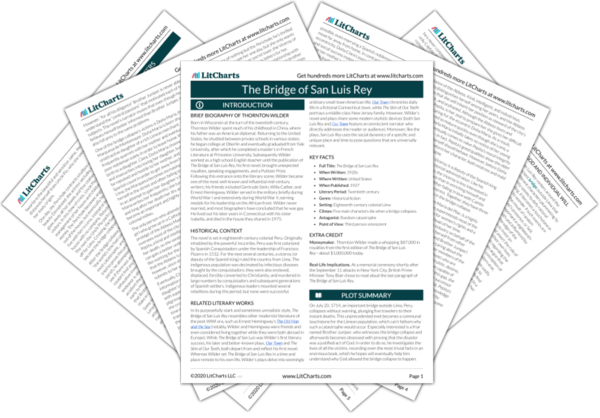As a Spanish outpost in the eighteenth century, Lima is an extremely faith-based society. Religious institutions and officials of those institutions abound, from the Archbishop to the Abbess. On one hand, these institutions often emerge as founts of hypocrisy, permitting and even fostering social injustice. An immensely corpulent and extravagantly attired man, the Archbishop enriches himself at the expense of the faithful. He firmly believes that “the injustice and unhappiness in the world is a constant,” and that “the poor, never having known happiness, are insensible to misfortune”; these principles allow him to sit by in indifference while corrupt priests imitate him and energetically scam their parishioners.
On the other hand, as the steward of the city’s hospitals and orphanages, the Abbess is a religious official who is actively engaged in fighting various social ills. In contrast to the Archbishop, she spends her free time dreaming of future societies in which “injustice and unhappiness” have been vanquished, and she exhausts herself trying to ameliorate the condition of the poor and helpless. The devotion and respect she’s accorded by her charges—namely, Pepita, Manuel, and Esteban—demonstrate the sincerity and efficiency of her efforts. It’s important that the same institution—the Roman Catholic Church—that empowers the Archbishop to abuse his power also spurs the Abbess to great altruism. Spurning dogma of all sorts, Wilder refuses to condemn religious institutions. Instead, he illustrates their ability to bring out the best and worst of different characters, and to function to the city’s benefit and detriment.
Churches and Abbeys Quotes in The Bridge of San Luis Rey
She was one of those persons who have allowed their lives to be gnawed away because they have fallen in love with an idea several centuries before its appointed appearance in the history of civilization. She hurled herself against the obstinacy of her time in her desire to attach a little dignity to women.
She was listening to the new tide of resignation that was rising within her. Perhaps she would learn in time to permit both her daughter and her gods to govern their own affairs.
The Archbishop knew that most of the priests of Peru were scoundrels. It required all his delicate Epicurean education to prevent his doing something about it; he had to repeat over to himself his favorite notions: that the injustice and unhappiness of the world is a constant; that the theory of progress is a delusion; that the poor, never having known happiness, are insensible to misfortune. Like all the rich he could not bring himself to believe that the poor (look at their houses, look at their clothes) could really suffer.
“All, all of us have failed. One wishes to be punished. One is willing to assume all kinds of penance, but do you know, my daughter, that in love—I scarcely dare say it—but in love our very mistakes don’t seem to be able to last long?”
But the love will have been enough; all those impulses of love return to the love that made them. Even memory is not necessary for love. There is a land of the living and a land of the dead and the bridge is love, the only survival, the only meaning.












